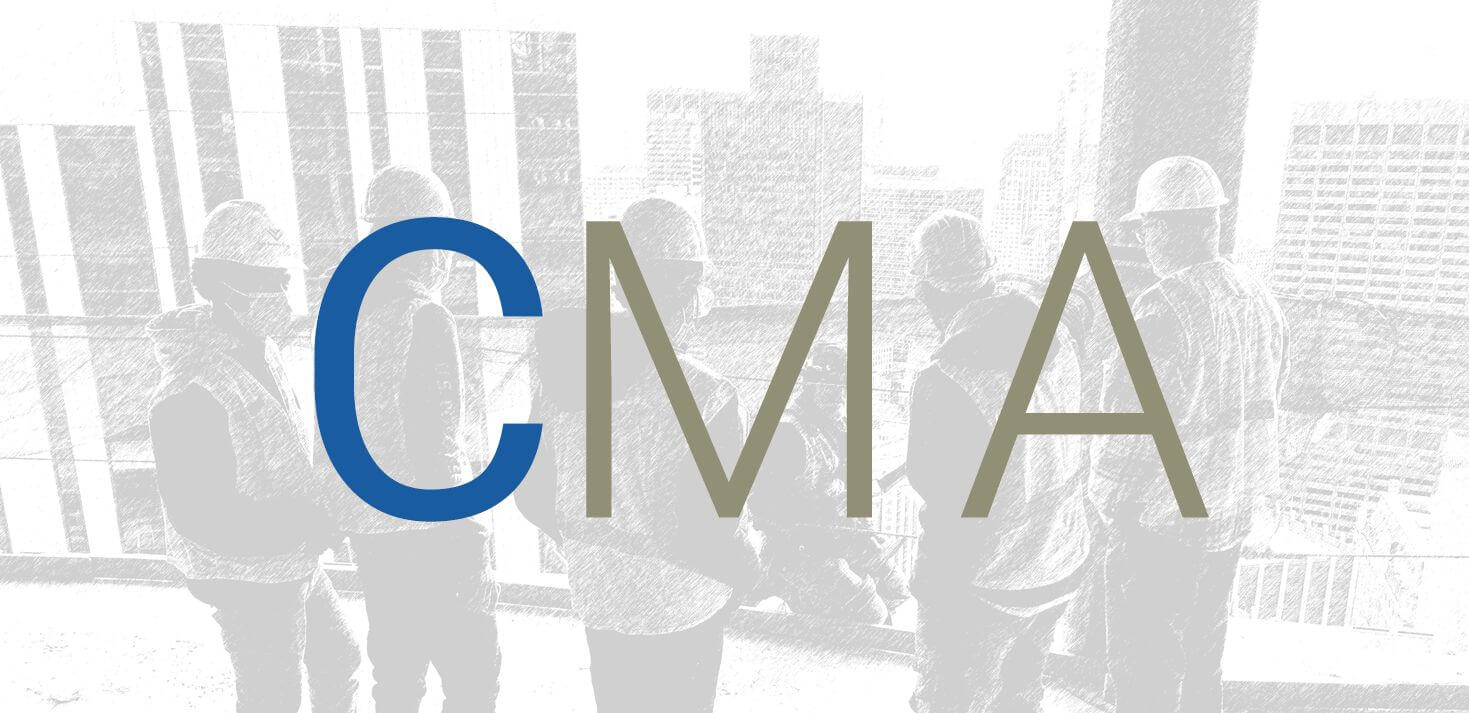Explore the various job opportunities within each category and find out what each skilled trade job entails, what you’ll need to know to build your own construction career and to see how much you could earn!
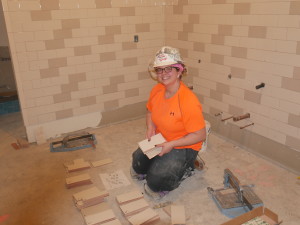 Bricklayers construct walls, partitions, fireplaces, chimneys, and other structures from brick, block, and other masonry materials such as structural tile, concrete cinder, glass, gypsum, and terra cotta. They spread a layer or "bed" of soft mortar that serves as base and binder using a trowel. The brick or block is then positioned and the excess mortar removed.
Bricklayers construct walls, partitions, fireplaces, chimneys, and other structures from brick, block, and other masonry materials such as structural tile, concrete cinder, glass, gypsum, and terra cotta. They spread a layer or "bed" of soft mortar that serves as base and binder using a trowel. The brick or block is then positioned and the excess mortar removed.
Bricklayers must understand and work from blueprints, and be able to use measuring, leveling, and aligning tools to check their work.
Working Conditions
- Majority outdoors and weather dependent
- Kneeling, lifting, standing
Aptitude and Interest
- Meticulous
- Accurate
- Detailed
- Good vision
- Manual dexterity
Training
To become a skilled bricklayer training is essential.
- learning-by-working;
- company on-the-job training programs;
- trade or vocational/technical schools;
- unilaterally (management or labor) sponsored trainee programs;
- through registered, labor-management apprenticeship programs;
- or a combination of the above.
Recommended high school courses include algebra, geometry, general science, mechanical drawing, and English.
Click here here to learn of the various training options available in the Boston area
Wages
1st year union Apprentice: $30/hour in wages + $30/hour in benefits
Union Tradesperson: $60/hour in wages + $35/hour in benefits
1st year open shop: $20/hour in wages + $10/hour in benefits

Carpenters possess skills and perform work which is basic to most building construction. They erect wood framework in buildings, build forms for concrete, and erect partitions, studs, joints, drywalls, and rafters, and install all types of floor coverings, ceilings, paneling, trim, and interior systems. Some carpenters construct docks and work with large timbers and drive piles to support the foundations of buildings and bridges.
Another branch of the trade, called millwrights, installs heavy machinery in industrial plants and turbine generators in power plants.
All carpenters use a wide variety of hand and power tools, and they must be able to maintain their tools in good, safe working order.
Working Conditions
- Work in crews with other tradespeople
- Indoors & Outdoors
- Confined spaces
- Climbing, lifting, carrying
- Reaching, balancing, kneeling, crawling
Aptitude and Interest
- Precise
- Accurate
- Craftsman
- Independent
- Adaptable
- Manual dexterity
- Problem solver
Training
To become a skilled carpenter training is essential.
- learning-by-working;
- company on-the-job training programs;
- trade or vocational/technical schools;
- unilaterally (management or labor) sponsored trainee programs;
- through registered, labor-management apprenticeship programs;
- or a combination of the above.
Recommended high school courses include algebra, general science, mechanical drawing, English, blueprint reading, and general shop.
Click here to learn more about all of the training opportunities in the Boston area
Wages
1st Year union Apprentice: $30/hour in wages and $25/hour in benefits
Union Tradesperson: $55/hour in wages and $30/hour in benefits
1st year open shop: $20/hour in wages and $10/hour in benefits
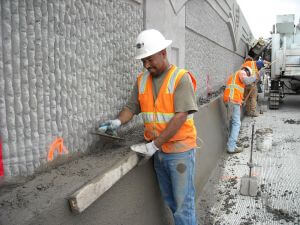 Cement masons level, smooth, and shape surfaces of freshly poured concrete on projects ranging from patios and basements to dams, highways, and foundations and walls of buildings.
Cement masons level, smooth, and shape surfaces of freshly poured concrete on projects ranging from patios and basements to dams, highways, and foundations and walls of buildings.
Cement masons must have a thorough knowledge of concrete characteristics and related materials. Also, they must know the effects of heat, cold, and wind on the curing of concrete. They must be able to tell by sight and touch what is happening to concrete in order to prevent defects.
Working Conditions
- Outdoors/exposed
- Weather/temperature dependent
- Muddy, dusty, and dirty
- Kneeling, slogging, carrying, lifting
Aptitude and Interest
- Hardworking
- Tenacious
- Dependable
- Independent
- Craftsmanship
Training
To become a skilled cement mason training is essential.
- learning-by-working;
- company on-the-job training programs;
- trade or vocational/technical schools;
- unilaterally (management or labor) sponsored trainee programs;
- through registered, labor-management apprenticeship programs;
- or a combination of the above.
It is generally accepted that the more formalized training programs give more comprehensive skill training. Recommended high school courses include English, math, mechanical drawing, and general science.
Click here to learn more about all of the training opportunities in the Boston area
Wages
1st year union Apprentice: $30/hour in wages + $30/hour in benefits
Union Tradesperson: $55/hour in wages + $35/hour in benefits
1st year open shop: $25/hour in wages + $10/hour in benefits
 Electricians lay-out, install, and test electrical service and electrical wire systems used to provide heat, light, power, air conditioning, and refrigeration in homes, office buildings, factories, hospitals, and schools. They also install conduit and other materials, and connect electrical machinery, equipment, and controls and transmission systems.
Electricians lay-out, install, and test electrical service and electrical wire systems used to provide heat, light, power, air conditioning, and refrigeration in homes, office buildings, factories, hospitals, and schools. They also install conduit and other materials, and connect electrical machinery, equipment, and controls and transmission systems.
Working Conditions
- Inside and outside
- All weather
- Confined spaces
- Standing, reaching, bending, stooping, climbing, carrying, and lifting
Aptitude and Interest
- Detailed
- Careful
- Mathematically oriented
- Independent
- Steady
- Patient
- Comprehension
- Manual dexterity
- Sequenced
- Color vision
Training
To become a skilled electrician training is essential and trade licenses are required.
- learning-by-working
- company on-the-job training programs
- trade or vocational/technical schools
- unilaterally (management or labor) sponsored trainee programs
- through registered, labor-management apprenticeship programs
- or a combination of the above
Recommended high school courses include English, algebra, geometry, trigonometry, physics, mechanical drawing, blueprint reading, and general shop.
Click here to learn more about all of the training opportunities in the Boston area
Wages
1st year union Apprentice: $25/hour in wages + $20/hour in benefits
Union Tradesperson: $65/hour in wages + $35/hour in benefits
1st year open shop: $25/hour in wages + $10/hour in benefits
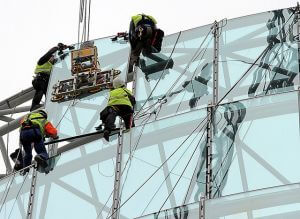 In the construction industry glaziers are responsible for the sizing, cutting, fitting, and setting of all glass products into openings of all kinds. Basically, glaziers perform two types of glass settings. The first and most common is the installation of glass in windows and doors. The second type of glass work is the installation of structural glass. This type of glass is used as decoration for ceilings, walls, building fronts, and partitions.
In the construction industry glaziers are responsible for the sizing, cutting, fitting, and setting of all glass products into openings of all kinds. Basically, glaziers perform two types of glass settings. The first and most common is the installation of glass in windows and doors. The second type of glass work is the installation of structural glass. This type of glass is used as decoration for ceilings, walls, building fronts, and partitions.
Working Conditions
- Inside in small crew or alone
- Outside with other trades
- Lifting, carrying, positioning, holding large panes
- Reaching, stretching, climbing
- Working at heights
Aptitude and Interest
- Patient
- Careful
- Meticulous
- Manual dexterity
- Steady
- Align by eye
Training
To become a skilled glazier training is essential;
- learning-by-working
- company on-the-job training programs
- trade or vocational/technical schools
- unilaterally (management or labor) sponsored trainee programs
- through registered, labor-management apprenticeship programs
- or a combination of the above
Recommended high school courses include general mathematics, blueprint reading, and general shop.
Click here to learn more about all of the training opportunities in the Boston area
Wages
1st year union Apprentice: $25/hour in wages + $25/hour in benefits
Union Tradesperson: $50/hour in wages + $30/hour in benefits
1st year open shop: $20/hour in wages + $10/hour in benefits
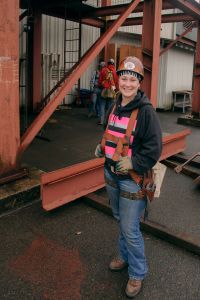 Iron Workers erect the steel framework for industrial, commercial, multi-unit residential buildings. They erect, bolt or weld the fabricated structural metal members that support the structure during and after construction. Iron Workers also install the metal decking for the floors and roof systems.
Iron Workers erect the steel framework for industrial, commercial, multi-unit residential buildings. They erect, bolt or weld the fabricated structural metal members that support the structure during and after construction. Iron Workers also install the metal decking for the floors and roof systems.
Some iron workers also set steel bars (rebar) or steel mesh in forms to strengthen concrete structures.
Other iron workers, called Miscellaneous & Ornamental Iron Workers, install and assemble grills, canopies, stairways, iron ladders, decorative iron railings, posts, and gates.
Working Conditions
- Working in a crew
- Majority outdoors with limited weather cancellations
- Regularly work at heights
- Climbing, balancing, kneeling, lifting, standing.
- Wearing a safety harness attached to lines to protect against a fall hazard
Aptitude and Interest
- Manual dexterity
- Meticulous
- Fine Motor skills
- Awareness of surroundings
- Not afraid to work at height
Training
To become a skilled Iron Worker training is essential.
- company on-the-job training programs
- trade or vocational/technical schools
- unilaterally (management or labor) sponsored trainee programs
- through registered, labor-management apprenticeship programs
- or a combination of the above
Recommended high school courses include English, general math, basic algebra, geometry, mechanical drawing, blueprint reading and welding.
Click here to learn more about all of the training opportunities in the Boston area
Wages
1st year union Apprentice: $30/hour in wages + $30/hour in benefits
Union Tradesperson: $50/hour in wages + $40/hour in benefits
1st year open shop: $20/hour in wages + $20/hour in benefits
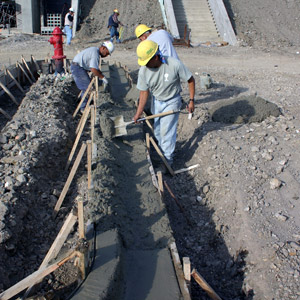 Laborers are generally needed on virtually all types of construction projects - highways, bridges, tunnels, large buildings, sanitation, residential, etc. - and they are usually employed on-site from the day the project begins until the day it is completed. Laborers perform numerous functions on a project site including handling materials for other trades, excavation, concrete placement, compaction, welding, general clean up and using tools and machines. A laborer must know how to work with his/her hands and with power tools run by gasoline, electricity, and compressed air. They may work with pavement breakers, reamers, pumps, compressors, lasers, and vibrators. Laborers clear timber and brush, place and vibrate concrete, landscape, install pipe, and do a variety of other jobs.
Laborers are generally needed on virtually all types of construction projects - highways, bridges, tunnels, large buildings, sanitation, residential, etc. - and they are usually employed on-site from the day the project begins until the day it is completed. Laborers perform numerous functions on a project site including handling materials for other trades, excavation, concrete placement, compaction, welding, general clean up and using tools and machines. A laborer must know how to work with his/her hands and with power tools run by gasoline, electricity, and compressed air. They may work with pavement breakers, reamers, pumps, compressors, lasers, and vibrators. Laborers clear timber and brush, place and vibrate concrete, landscape, install pipe, and do a variety of other jobs.
Working Conditions
- Wide variety of working conditions
- Indoors and outdoors
- Underground and at heights
- Considerable lifting, carrying, climbing, kneeling, balancing, and even crawling
Aptitude and Interest
- Strength
- Dexterity
- Alertness
- Multi-skilledAs a supporter of other skilled craftsmen, laborers' work requires that their skills be diversified. It is not enough to have a strong back and will to work. Laborers should master basic reading and math skills necessary to operate today's increasingly complex and highly technical tools, equipment, and instruments.
Training
To become a skilled laborer training is essential;
- learning-by-working
- company on-the-job training programs
- trade or vocational/technical schools
- unilaterally (management or labor) sponsored trainee programs
- through registered, labor-management apprenticeship programs
- or a combination of the above
Recommended high school courses include English and basic math.
Click here to learn more about all of the training opportunities in the Boston area
Wages
1st year union Apprentice: $25/hour in wages + $25/hour in benefits
Union Tradesperson: $40/hour in wages and $35/hour in benefits
1st year open shop: $20/hour in wages + $10/hour in benefits
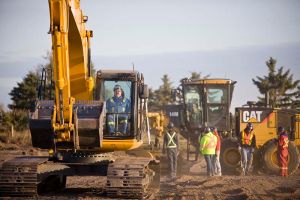 Operating Engineers or Equipment Operators control and maintain a variety of powerful equipment ranging from bulldozers, backhoes, and earthmovers to very large power shovels and cranes. They also lubricate, maintain, and perform minor repair and adjustment to the machinery.
Operating Engineers or Equipment Operators control and maintain a variety of powerful equipment ranging from bulldozers, backhoes, and earthmovers to very large power shovels and cranes. They also lubricate, maintain, and perform minor repair and adjustment to the machinery.
Working Conditions
- Outdoors and inside machinery
- Can be at heights
- Weather-dependent
- Climbing, sitting for long periods
- Jarring, jolting, and continuous noise
Aptitude and Interest
- Good coordination to operate hand and foot levers
- Strong eyesight
- Steady and patient.
- Highly cooperative
- Alert and observant
Training
As many machines require specific licenses to operate, training is essential;
- learning-by-working
- company on-the-job training programs
- trade or vocational/technical schools
- unilaterally (management or labor) sponsored trainee programs
- through registered, labor-management apprenticeship programs
- or a combination of the above
Recommended high school courses include English, algebra, geometry, general sciences, and mechanical drawing.
Click here to learn more about all of the training opportunities in the Boston area
Wages
1st year union Apprentice: $35/hour in wages + $30/hour in benefits
Union Tradesperson: $65/hour in wages + $35/hour in benefits
1st year open shop: $30/hour in wages +$10/hour in benefits
 These are two separate skills, but many craftsmen learn to do both. The methods of preparation and application are different, but both jobs are concerned with covering walls and surfaces.
These are two separate skills, but many craftsmen learn to do both. The methods of preparation and application are different, but both jobs are concerned with covering walls and surfaces.
Painters prepare surfaces and apply paint, varnish, enamel, lacquer, and similar materials to wood, metal, or masonry buildings using brushes, rollers or a spray gun. Painters also mix pigments, oils, and other ingredients to obtain the required color and consistency.
 Paperhangers also prepare surfaces, measure and cut wall coverings to size, paste, position and match designs, and work the air bubbles out to leave a smooth surface. A wide variety of specialized tools are used as well as a variety of fabric, vinyl, or other materials.
Paperhangers also prepare surfaces, measure and cut wall coverings to size, paste, position and match designs, and work the air bubbles out to leave a smooth surface. A wide variety of specialized tools are used as well as a variety of fabric, vinyl, or other materials.
Working Conditions
- Mostly indoors
- Some work at heights
- Work alone or in crews
- Stand, stoop, turn, crouch, crawl, kneel and frequently climb scaffolds and ladders.
Aptitude and Interest
- Detail-Oriented
- Manual Dexterity
- Steady
Training
To become a skilled painter or paperhanger training is essential.
- learning-by-working
- company on-the-job training programs
- trade or vocational/technical school
- unilaterally (management or labor) sponsored trainee programs
- through registered, labor-management apprenticeship programs
- or a combination of the above
Recommended high school courses include art, chemistry, general shop, interior decorating, math, and woodwork finishing.
Click here to learn more about all of the training opportunities in the Boston area
Wages
1st year union Apprentice: $25/hour in wages + $25/hour in benefits
Union Tradesperson: $45/hour in wages +$35/hour in benefits
1st year open shop: $20/hour in wages +$10/hour in benefits
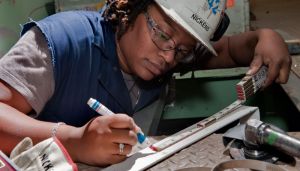 Pipefitters work from blueprints to determine the size and placement of piping, valves, and equipment. They assemble, install, and maintain pipes carrying liquids, steam, compressed air, gases, and fluids needed for processing, manufacturing, heating, and cooling. They must be able to change and repair pipe systems and do all types of welding and joining. They measure, cut, bend, and thread pipes, joining sections together as necessary using elbows, "T" fittings, or other couplings. Tools used include wrenches, reamers, drills, hammers, chisels, saws, gas torches, gas or electric welding equipment, pipe cutters, benders, and threaders.
Pipefitters work from blueprints to determine the size and placement of piping, valves, and equipment. They assemble, install, and maintain pipes carrying liquids, steam, compressed air, gases, and fluids needed for processing, manufacturing, heating, and cooling. They must be able to change and repair pipe systems and do all types of welding and joining. They measure, cut, bend, and thread pipes, joining sections together as necessary using elbows, "T" fittings, or other couplings. Tools used include wrenches, reamers, drills, hammers, chisels, saws, gas torches, gas or electric welding equipment, pipe cutters, benders, and threaders.
Working Conditions
- Active and sometimes strenuous
- Subject to hot and cold temperatures and fumes
- Standing for prolonged periods on ladders or on scaffolds
- Occasionally cramped or in enclosed spaces
- May work indoors or outdoors in unfinished sections of new buildings or machine rooms
Aptitude and Interest
- Detailed
- Meticulous
- Dexterous
- Systematic
- Accurate
- Good at arithmetic
Training
To become a pipefitter/steamfitter training is essential and professional licenses are required;
- learning-by-working
- company on-the-job training programs
- trade or vocational/technical schools
- unilaterally (management or labor) sponsored trainee programs
- through registered, labor-management apprenticeship programs
- or a combination of the above
Recommended high school courses include English, general math, algebra, geometry, trigonometry, general science, physics, and mechanical drawing. Welding experience is a plus.
Click here to learn more about all of the training opportunities in the Boston area
Wages
1st year union Apprentice: $30/hour in wages + $30/hour in benefits
Union Tradesperson: $50/hour in wages + $45/hour in benefits
1st year open shop: $25/hour in wages + $15/hour in benefits
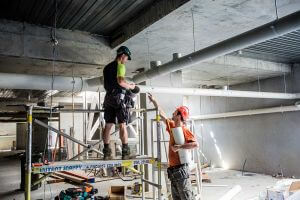 Plumbers are skilled craftsmen who install, repair, and alter pipe systems that carry gases, water and other liquids required for sanitation, storm water, industrial production, and other uses. They install plumbing fixtures, appliances, bathtubs, basins, sinks, showers, and grease line systems. They work from blueprints and working drawings to determine materials required for installation. They cut and thread pipe using pipe cutters, cutting torches, and pipe threading machines. They connect pipe using mechanical and soldered joints.
Plumbers are skilled craftsmen who install, repair, and alter pipe systems that carry gases, water and other liquids required for sanitation, storm water, industrial production, and other uses. They install plumbing fixtures, appliances, bathtubs, basins, sinks, showers, and grease line systems. They work from blueprints and working drawings to determine materials required for installation. They cut and thread pipe using pipe cutters, cutting torches, and pipe threading machines. They connect pipe using mechanical and soldered joints.
Working Conditions
- Plumbers typically work indoors, but may be outdoors
- Can work on a ladder or scaffold, underground in a trench, a crawl space under a building, or in the unfinished basement of a new building.
- Can be dirty and messy in dusty or muddy conditions.
- Active and strenuous, with standing, bending, crawling, lifting, pulling, and pushing, and is often done in strict accordance with the state plumbing and mechanical code regulations.
Aptitude and Interest
- Detailed
- Meticulous
- Dexterous
- Systematic
- Accurate
- Service Oriented
Training
To become a skilled plumber training is essential and trade licenses are required;
- learning-by-working
- company on-the-job training programs
- trade or vocational/technical schools
- unilaterally (management or labor) sponsored trainee programs
- through registered, labor-management apprenticeship programs
- or a combination of the above
It is generally accepted that the more formalized training programs give more comprehensive skill training. Recommended high school courses include English, math, drafting, blueprint reading, physics, and chemistry.
Click here to learn more about all of the training opportunities in the Boston area
Wages
1st year union Apprentice: $30/hour in wages + $30/hour in benefits
Union Tradesperson: $50/hour in wages + $45/hour in benefits
1st year open shop: $25/hour in wages + $15/hour in benefits
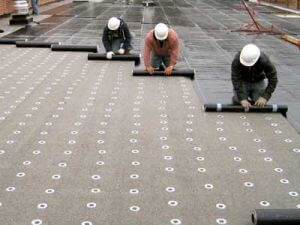 Commercial roofers apply built-up composition roofing and many other materials such as tile, slate, composition shingles, metals, various types of plastic materials, and other surfaces. Roofers also remove old materials in preparation for new roofing material. Some of the equipment they use tar kettles, power-operated hoists and lifts, compressors, shingle removing equipment, and spray rigs. Typically, commercial roofers on on flat roofs, but sloped roofing may also occur.
Commercial roofers apply built-up composition roofing and many other materials such as tile, slate, composition shingles, metals, various types of plastic materials, and other surfaces. Roofers also remove old materials in preparation for new roofing material. Some of the equipment they use tar kettles, power-operated hoists and lifts, compressors, shingle removing equipment, and spray rigs. Typically, commercial roofers on on flat roofs, but sloped roofing may also occur.
Working Conditions
- Long periods of exposure to the elements
- Work in crews
- Weather Dependent
- Work is at height, (on roofs or scaffolds)
- Work is strenuous and involves standing, lifting, climbing, bending, and squatting, often in a very hot environment.
Aptitude and Interest
- Not averse to heights
- Able to work in very hot or very cold weather conditions
- Team-oriented
- Strong, with flexible muscles and joints
- Detailed
Training
To become a skilled roofer training is essential;
- learning-by-working
- company on-the-job training programs
- trade or vocational/technical schools
- unilaterally (management or labor) sponsored trainee programs
- through registered, labor-management apprenticeship programs
- or a combination of the above
Recommended high school courses include mathematics, blueprint reading, and general shop. Fall protection training is a plus.
Click here to learn more about all of the training opportunities in the Boston area
Wages
1st year union Apprentice: $25/hour in wages + $20/hour in benefits
Union Tradesperson: $40/hour in wages + $35/hour in benefits
1st year open shop: $20/hour in wages + $10/hour in benefits
 Sheet metal workers read sketches and blueprints to fabricate products made from sheets of steel, aluminum, copper, and other materials. They then install these metal products on walls, ceilings, and roofs. A sheet metal worker uses hand or power-operated tools such as shears, breaks (for bending), punch and forming presses, and rolling and crimping machines to cut, bend, and shape the metal. They build the heating, air conditioning, ventilation, and exhaust system ducts in commercial and industrial buildings and homes as well as a variety of decorative and functional metal roofing products. Sheet metal workers may be employed in a fabrication shop or on active construction sites.
Sheet metal workers read sketches and blueprints to fabricate products made from sheets of steel, aluminum, copper, and other materials. They then install these metal products on walls, ceilings, and roofs. A sheet metal worker uses hand or power-operated tools such as shears, breaks (for bending), punch and forming presses, and rolling and crimping machines to cut, bend, and shape the metal. They build the heating, air conditioning, ventilation, and exhaust system ducts in commercial and industrial buildings and homes as well as a variety of decorative and functional metal roofing products. Sheet metal workers may be employed in a fabrication shop or on active construction sites.
Working Conditions
- May work inside in fabrication shops, outside on roofs or on enclosed construction sites
- Most work in crews
- Climbing, balancing, lifting, standing
- Some work on ladders, lifts or at heights
Aptitude and Interest
- Overhead strength
- Steady
- Dexterous
- Not afraid to work at heigt
- Meticulous
- Careful
Training
To become a skilled sheet metal worker training is essential and trade licenses are required;
- learning-by-working
- company on-the-job training programs
- trade or vocational/technical schools
- unilaterally (management or labor) sponsored trainee programs
- through registered, labor-management apprenticeship programs
- or a combination of the above
Recommended high school courses include English, algebra, geometry, general sciences, and mechanical drawing. Welding is a plus.
Click here to learn more about all of the training opportunities in the Boston area
Wages
1st year union Apprentice: $35/hour in wages + $30/hour in benefits
Union Tradesperson: $45/hour in wages + $40/hour in benefits
1st year open shop: $25/hour in wages + $10/hour in benefits
Career Options

Explore Apprenticeships in Massachusetts
Apprenticeships run the gamut from traditional building and construction trades jobs to those in the hottest
technology-powered fields such as cloud computing and healthcare.
The Ultimate Guide to Becoming a Union Building Trade Apprentice
Apprenticeship is a unique way to begin a career through paid, hands‐on training combined with classroom instruction. As an apprentice you will be trained by a certified, journey‐level worker on the job site and receive at least 125 hours per year of instruction in the classroom.
This model allows you to EARN WHILE YOU LEARN!
